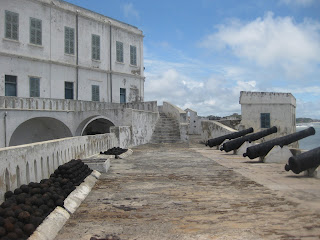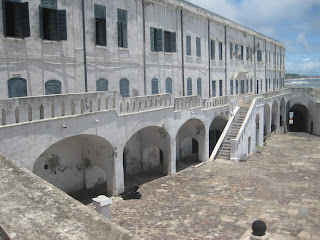Ghana’s history is very rich and full of beauty, with the large exception of slavery. But slavery and the slave trade are as much a part of their history as anything else. People don’t hold grudges, but they also don’t forget the history and are hard at work to make sure that others don’t forget as well. One of the biggest memories still in existence are the slave castles.
 |
| St. George's Castle, Elmina |
There are three castles in Ghana, Osu Castle in Accra, Cape Coast Castle in Cape Coast, and St. George’s Castle in Elmina. The Osu Castle is used as a government building, but the other two are open for people to tour and learn about their history’s and activity’s.
I have gotten the privilege the tour both the castles, a few times actually. They are quite the experience. You know, we learn about slavery and all that in school growing up, but it becomes quite real when you are standing in a place where it actually happened. It is heart-wrenching to imagine people chained up for months and then shipped away from their hometown. And the cruel treatment they received is appalling, but it’s interesting because I wouldn’t describe the castle atmospheres as morbid. I mean it is a bit gloomy, but it is more seen as a place of education, a place to teach people about the realities of our world history so we can appreciate how far we have come and make sure the past never repeats itself. So overall, I learned a lot and of course wish the past was different, but am thankful our world has come to realize it’s wrongs and work to change them.
 |
| Real and Old Canon Balls! |
So here is some information about one of the castles, St. George’s or Elmina Castle. My dad and I just toured it last week so the facts are fresh in my head.
The Elmina Castle was built in 1482 by the Portuguese. That means the castle is 528 years old! It is all original except for the wooded parts such as the floors, stairs, and windows. Also, when the Ghanaians took the castle back from the British after their 1957 independence, they cemented over the original red bricks and painted the building white. Otherwise, the structure is as it was way back when. The Portuguese first came to the Ghanaian coast to trade with the local people. They brought guns, gunpowder, and other general commodities and traded them for the gold that was abundantly found in Ghana. That is why the country used to be called the Gold Coast. But as time went on, the Portuguese decided to shift their business to exporting slaves. They would capture the local people by force and keep them in the commodity storage rooms, what are now called the dungeons.
Seeing how prosperous the Portugues were being, the Dutch decided to come and tried to take over the castle. After one failed attempt, some local Ghanaians went to help the Dutch in hopes that if the Portuguese were made to leave, the raids and stealing of their people would end. So after 150 years of ruling the area, the Portuguese-built castle was turned over the Dutch. But the slave trade did not end, but only got worse.
The castle help 1,000 slaves at one time, 600 men and 400 women. They were kept on the ground level in the dungeons, basically they were just stone holding cells. One of the female dungeons were in held 150 women. My dad measured how big the room was and came up with about 1200 square feet which means that each person had only about 8 square feet to live in. There were no toilet facilities so the slaves were living in their filth (urine, vomit, menstrual discharge, feces) and in near to complete darkness (there was only sunlight coming out of the one or two ventilation windows). They were fed the bare minimum 1-2 times a day. They were kept there for about 2-3 months before being exported and were never allowed to bathe, unless they were about to be raped by the governor.
 |
| One of the male slave dungeons |
Whenever the governor had a sexual appetite, all the women were brought out of the dungeons to a small, central courtyard where the governor, standing on his balcony above, would pick out the woman he wanted, often by singing the “Eenie Meenie Miney Mo” song in the Dutch language. This woman was given a bath and made to climb the ladder to the governor’s quarters. When he was finished with her, she was forced back to the dungeons. Any woman who resisted was punished by being forced to stand in the sun, shackled made to hold a heavy canon ball all day long. Any woman who got pregnant from the governor, was released to live in a house in town. The mulatto children were sent to school in the castle and treated with special care because they were the governor’s children.
 |
| Governor's quarters |
When the traders were ready to send a shipment of slaves, the men and women were lead to the “room of no return” through the “door of no return” out onto the ships. They were then sent all over the world.
 |
| The door of no return. This was the last time they were on the soils of Ghana. |
The British came in many, many years later and traded for the castle. They had taken part in the slave trade previously, but at this point decided to ban it and transformed the castle into a military holding and training facility. The British held the castle until Ghana gained it’s independence from them in 1957 and took over the castle.
Interesting stuff, huh?!
 |
| One of the churches at the castle. |
 |
| The punishment room for the Freedom Fighters - the slaves who fought back...this room was a death sentence |
 |
| A nearby fort...I forget what's it use was... |
 |
| The ocean water used to go right up to the fort, but has since receded. |
 |
| There is a fishing harbor down below...too many people...WAY too many smelly fish! |
 |
| Part of the castle now houses cultural gift shops where you can find lots of cool things. You can see one of them in the bottom left corner of this picture. |






No comments:
Post a Comment